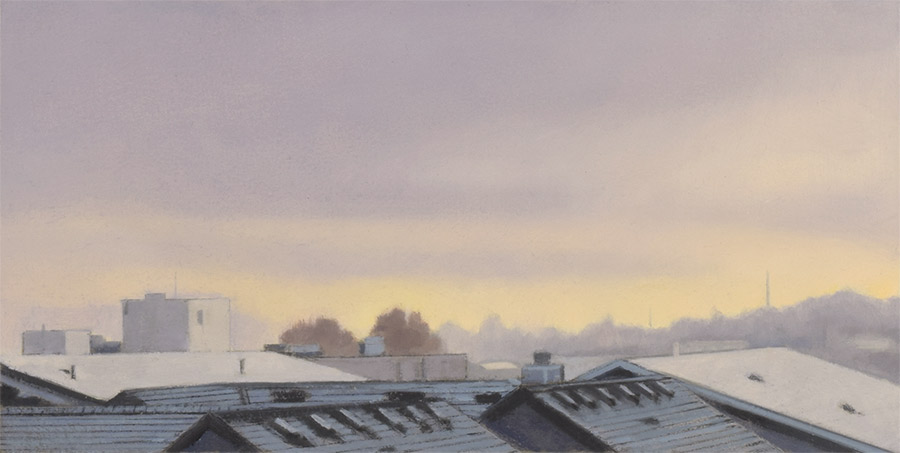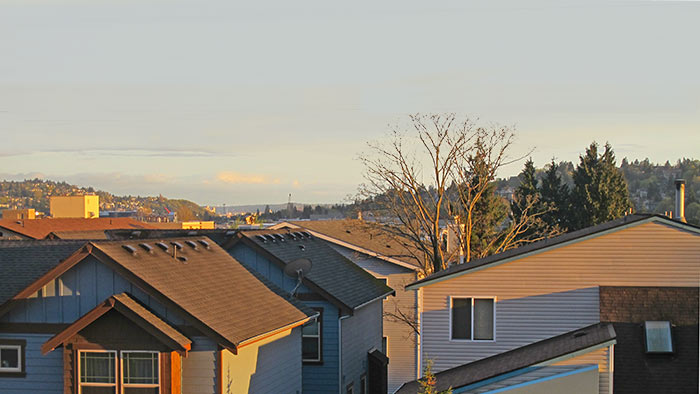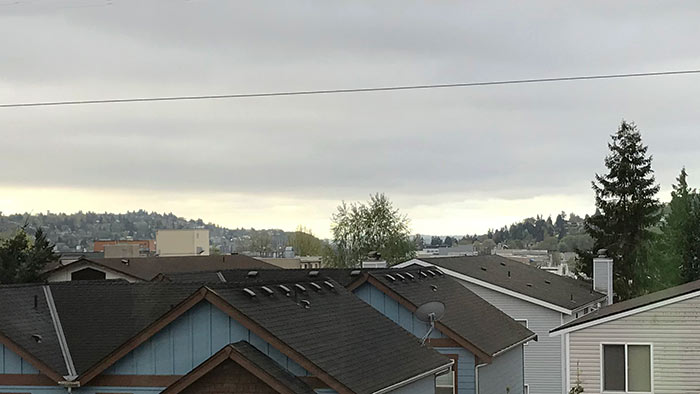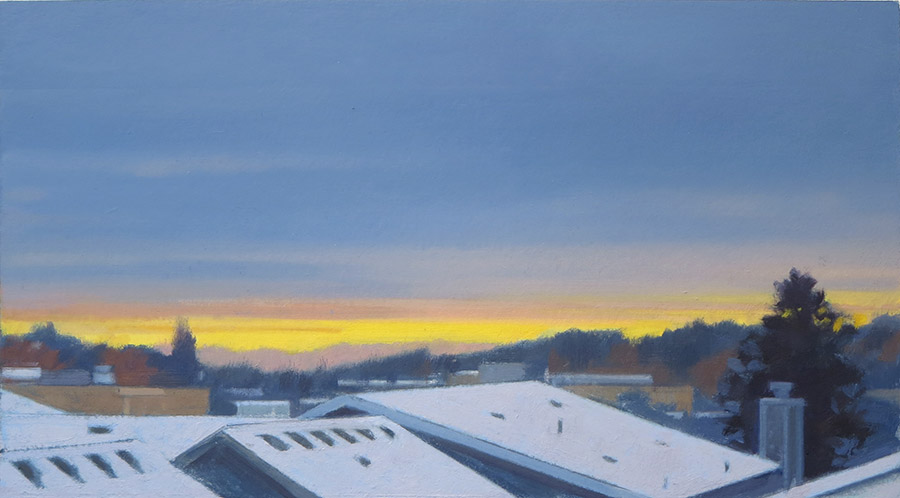I recently received two questions from readers on the topic of painting cloudy or overcast scenes. The first question has to do with whether one can transform an overcast scene into a sunny one. The second question asks whether adequate patterns of light and shadow can still be found on overcast days.

Rooftops 59th Street, Winter Dusk, oil on paper, 6″ x 12″. On overcast days the contrasts between light and shadow are diminished. One needs to look more closely to identify the value differences. Here, a gentle reveal of light along the horizon adds a much needed color note to an otherwise all gray painting.
Q: I have so many photos of cloudy and overcast scenes. Is possible to transform these into a sunlit scenes?
Answer. It’s possible — but it’s not the type of landscape transformation I recommend. Why? Color, along with light and shadow, behave differently on sunny and overcast days. On sunny days, colors are more saturated and value contrasts are much stronger. On overcast days, we find nearly the opposite: colors are less saturated and the contrasts between light and shadow are diminished. To transform a scene from “overcast” to “sunny,” you would have to be well-versed with these color and value differences, and that only comes from experience observing and mixing colors outdoors under both kinds of conditions. I don’t want to discourage anyone from taking liberties with color and value; that’s part of the process. However, this particular transformation is a stretch, even for the most experienced among us.
Instead, why not use cloudy day subjects to make cloudy day paintings, and sunny day subjects to create sunny day paintings? Part of the magic of painting landscape is attempting to capture the color of light under different atmospheric conditions and at different times of day. Although overcast subjects are more challenging, they can make for excellent subjects. The colors tend to be very harmonious. We get to play with neutral colors. And they convey their own type of mood.
Differences between sunny and overcast days
Here are two source photos from the series Rooftops, 59th Street, which demonstrate key differences between overcast and sunny days.

On sunny days (in the early morning or late afternoon) there is a strong crosslight. Patterns of light and shadow are more obvious, shapes are better differentiated, and the colors are richer and more saturated.

The same vantage point on an overcast day. The differences are remarkable. Although forms are still differentiated, the value differences are much subtler. Color saturation is significantly diminished and a neutral palette is called for.
Q: I understand the desire for morning or late afternoon light, so that you get adequate shadow patterns, but what do you do when it’s cloudy?
Answer: Adequate patterns of light and shadow always work to our advantage. (See Optimal Orientation of Subject and Artist in Plein Air.) They create form and volume and help distinguish shapes from one another. The next time you are outside on an overcast day, look closely, and you’ll notice that patterns of light and shadow are not absent — they are simply subtler and less contrasty than they are on a sunny day. Capitalize on that. Make sure to include those value differences, or even exaggerate them if necessary. Even from behind all those clouds, the sun still shines and creates a crosslight, albeit much weaker than on a sunny day. For that reason I would still recommend painting outside (or taking photos) in the early morning or late afternoon.

Rooftops 59th Street, Last Light, oil on paper, 6.75″ x 12″. In this scene there is heavy cloud cover above the horizon. On some overcast days there is a short period of time, just after sunrise or before sunset, when direct sunlight peeks out from beneath the canopy of clouds. This can reveal a striking color, as in this painting. Or it can allow direct sunlight to create a momentary crosslight and unexpected patterns of light and shadow. This doesn’t happen on all cloudy days, but it happens on some.
Lastly, a word about “flat light”
Cloudy or overcast subjects can have a beauty all their own. However, they do tend to present more flat light. Flat light is a lighting condition in which there is little crosslight and shadow patterns are at a minimum. With fewer volume-generating clues, forms tend to be flatter. We can find flat light on sunny days, too (usually when the sun is directly overhead), but it tends to occur more often on overcast days. Therefore, closer observation is needed when evaluating these types of subjects. If you’re a novice — still learning to manage values and mix colors — then I would recommend sticking with sunny day scenes. Patterns of light and shade will be clearer, value differences will be more noticeable, and colors will not be as subtle as they are on overcast days.
Flat light also occurs when the sun is directly in front of you or directly behind you, as we find in sunset scenes. Without the crosslight to create volume, we have only flat single-value and single-color shapes. Then a clear foreground, middle ground and background become even more important. And we rely more on other spatial cues like differences in scale, overlap, and perspective.
Additional Resources
Complete Rooftops, 59th Street series
from Landscape Painting: Essential Concepts and Techniques for Plein Air and Studio Practice:
Subjects with Diminished Cue, page 78
At this blog:
Landscape Color Strategies: Part 3 – The Harmony of Neutrals

1 Comment
Mitch,
It is always a delight to see the subtly of your paintings and to read your most excellent commentary and advice. I am impressed with the power and harmony of Rooftops 59th Street Last Light in spite of a very limited pallet, and Rooftops …Winter Dusk is even more limited. Did you deliberately restrict your pallet before starting to paint and play around with how you could express the scene with the fewest distinct colors?
While Last Light has a limited pallet, the colors are very rich. I lost my dislike of cloudy days when I learned that they can offer more, not less color than a sunny day! Sunlight can bleach out color and can create such contrast that subtle colors don’t fit. Cloudy days are a more challenging environment for the reasons you describe but the opportunity to do great work is well demonstrated in your Rooftop paintings!
Regarding Flat Light. I agree with everything you say and would add this. Flat Light, at least by my definition, also exists when the sun is directly at your back as in a morning or evening scene and cast shadows are hidden from view. When I started Plein Air painting I was drawn to such scenes for the brilliance of the light and it took me a while to learn that form, as you state, is most easily described by light coming from one side. It is the reason the typical still life has light shining brightly on one side with significant shadows. I learned to avoid flat light scenes, not just because they were difficult to do well, but also because I learned to love shadows as areas of potential rich color in my paintings and for the ease of describing forms of trees, rocks, etc., and because shadows create the contrast to make lights pop. Researching landscape painting masters like Clyde Aspevig, I found that while they do an occasional flat light painting, such paintings account for a very small portion of the paintings they show. In my experience, when flat light paintings are done by a master with the sun directly behind the painter, helpful devices are added to the composition, like a cast shadow immediately in front, and/or cloud shadows, under clouds and/or on the ground, or similar to help make up for what would otherwise be a scene without shadows.